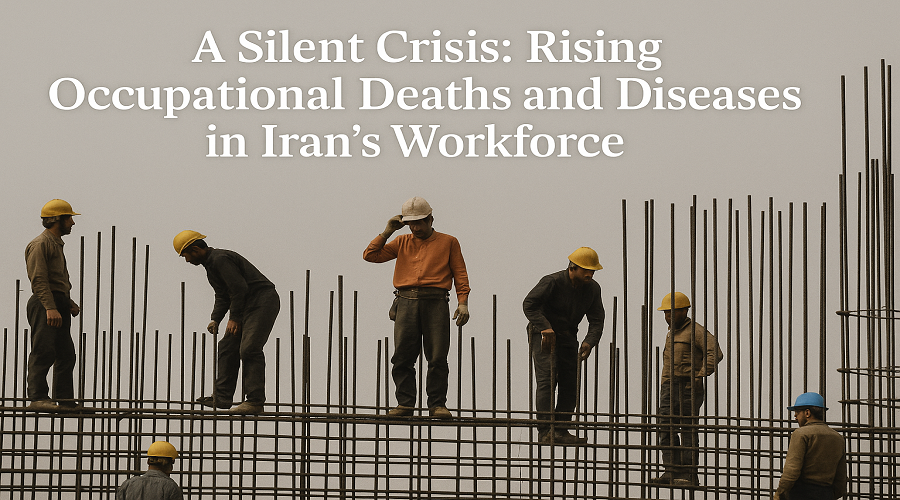Unseen Tragedy: Surge in Occupational Deaths and Diseases Plaguing Iran’s Workers
Recent data from Iran’s Forensic Medicine Organization has highlighted a troubling increase in workplace fatalities, revealing that at least 1,900 individuals lost their lives in occupational accidents over the past year. This alarming statistic is nearly four times higher than the 455 deaths reported by the Social Security Organization for 2022. Such a significant discrepancy raises serious questions about the accuracy of government statistics and the effectiveness of occupational safety monitoring in Iran.
The Social Security Organization’s figures are derived solely from insured workers, which may partially explain this disparity. However, the vast difference underscores deeper systemic issues—specifically, gaps in oversight and a failure to comprehensively document and prevent workplace hazards.
Mounting Reports of Occupational Illnesses
In addition to fatal accidents, Iran is experiencing a rise in occupational diseases, particularly among workers in high-risk sectors such as construction, manufacturing, and services. Recent media reports have drawn attention to declining safety standards across the country’s workplaces. These concerns are reinforced by findings from the Iranian Parliament’s Research Center. A 2023 report titled “Investigation of Work-Related Accidents and the Social Rights of Mine Workers” revealed that 3,826 insured workers died at their workplaces in 2021 and 2022, positioning workplace accidents alongside road crashes as leading causes of death in the country.
According to the same report, 84,638 workers were injured during this two-year period. However, only deaths among those with official insurance were documented, indicating a broader safety crisis that is likely underreported.
Official Numbers Fail to Capture the Full Picture
In a separate report released by the Ministry of Cooperatives, Labor and Social Welfare in May 2024, the government acknowledged approximately 10,000 work-related accidents annually, with around 800 resulting in fatalities. Notably, the construction and manufacturing industries accounted for 74 percent of these incidents.
Despite these statistics, experts argue that non-compliance with safety standards remains the primary cause of workplace accidents and illnesses. Common contributing factors include:
- Lack of effective safety training for both workers and employers
- Outdated or non-standard equipment
- Long working hours and excessive workloads
- Hazardous work environments
- Exposure to toxic substances
- Psychological stress, job insecurity, and social pressure
These conditions not only heighten the risk of accidents but also contribute to the development of chronic physical and mental illnesses among workers. In sectors like construction and services, ailments such as herniated discs, worn cartilage, torn ligaments, and chronic joint pain are prevalent.
A Growing Public Health Concern
As healthcare costs continue to rise and insurance coverage becomes increasingly limited, many workers are reluctant to seek medical treatment and diagnostic tests. This leads to worsening health outcomes over time. Untreated conditions significantly affect quality of life during both working years and retirement, placing an additional burden on Iran’s already strained social welfare and insurance systems.
A comparative glance at global standards reveals that Iran lags considerably behind developed nations in terms of occupational health and safety. This gap is not merely a question of infrastructure but also reflects a lack of political will and labor rights.
“The Silent Death of Workers”
On April 19, 2024, the labor newspaper Kar va Karegar published a report titled “The Silent Death of Workers”, which documented the alarming rise in occupational diseases. Akbar Shawkat, head of the Construction Workers’ Association, stated:
“According to global patterns, deaths from occupational diseases are five to seven times higher than those caused by sudden workplace accidents.”
He further estimated that if 2,000 workers die each year from workplace accidents, an additional 10,000 may succumb to long-term work-related illnesses—deaths that remain largely invisible due to a lack of official reporting and oversight.
A Hidden Majority: Iran’s Informal Labor Force
The official statistics likely underestimate the true scale of the crisis, as they only account for formally employed and insured workers. Labor activists estimate that about five million Iranians are employed without contracts or insurance, often in underground workshops where labor laws are routinely ignored. These workers are particularly vulnerable, and injuries or deaths among them frequently go unreported and uninvestigated.
More than 96 percent of Iran’s workforce is employed on temporary contracts, undermining job security and access to healthcare while diminishing workers’ ability to organize and advocate for better conditions.
Structural Failures and Union Suppression
Experts point to the systematic suppression of independent labor unions by the Iranian government as a root cause of ongoing unsafe working conditions. Without organized labor, workers lack the necessary tools to push for regulatory reforms or hold employers and officials accountable. This silence perpetuates preventable workplace deaths and long-term illnesses.
A Looming Crisis
Iran’s failure to address workplace safety transcends a mere labor issue—it represents a growing public health and economic crisis. In the first six months of 2024 alone, 1,077 deaths from occupational accidents were recorded, averaging nearly 200 deaths per month. Over the past five years, this marks a 30 percent increase, highlighting a concerning trend.
As Iran grapples with an aging population, the long-term consequences of widespread occupational illness and injury will increasingly burden its social support systems while undermining the health and productivity of its workforce.






